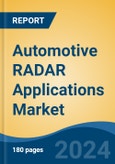Adaptive Cruise Control (ACC) is the fastest growing segment, North America is the largest market globally
Speak directly to the analyst to clarify any post sales queries you may have.
10% Free customizationThis report comes with 10% free customization, enabling you to add data that meets your specific business needs.
Key Market Drivers
The Global Automotive RADAR Applications Market is significantly influenced by stringent government regulations for vehicle safety and the growing adoption of Advanced Driver-Assistance Systems (ADAS). Governments worldwide are increasingly mandating features that rely heavily on radar technology to mitigate accidents and enhance occupant protection. For example, the U. S. National Highway Traffic Safety Administration (NHTSA) finalized a rule in May 2024 requiring automatic emergency braking (AEB) systems in new cars and light trucks by September 2029, with these systems often integrating radar sensors for effective object detection and speed measurement.Key Market Challenges
A significant challenge impeding further market expansion involves the intricate complexity of integrating multiple RADAR sensors with other sensor modalities and the substantial costs associated with sensor fusion. This challenge directly escalates overall vehicle development and manufacturing expenses, which can limit the widespread adoption of advanced RADAR systems, particularly in price-sensitive vehicle segments. Manufacturers must contend with higher capital expenditure in research and development, coupled with the technical difficulties of ensuring seamless operation and accurate data interpretation from diverse sensor types.Key Market Trends
A significant trend driving the Global Automotive RADAR Applications Market is the widespread adoption of 77-79 GHz radar systems. This transition to higher frequency bands offers superior resolution, enhanced accuracy, and enables more compact module designs. These attributes are crucial for precise object detection and classification in advanced driver-assistance systems and autonomous driving applications. In May 2025, Continental announced a milestone of producing 200 million radar sensors globally, with their recent generations operating at 77 GHz as standard.Key Market Players Profiled:
- Robert Bosch GmbH
- Continental AG
- DENSO Corporation
- ZF Friedrichshafen AG
- Aptiv PLC
- Texas Instruments Inc.
- HELLA GmbH and Co. KGaA
- NXP Semiconductors N.V.
- Infineon Technologies AG
- Analog Devices Inc.
Report Scope:
In this report, the Global Automotive RADAR Applications Market has been segmented into the following categories:By Frequency:
- 24 GHz
- 77 GHz
- 79 GHz
By Application:
- Adaptive Cruise Control (ACC)
- Blind Spot Detection (BCD)
- Forward Collision Warning System (FCWS)
- Lane Departure Warning System (LDWS)
- Parking Assistance (PA)
By Technology:
- Lidar
- Millimeter-Wave Radar
- Camera
- Ultrasonic Radar
By Region:
- North America
- Europe
- Asia Pacific
- South America
- Middle East & Africa
Competitive Landscape
Company Profiles: Detailed analysis of the major companies present in the Global Automotive RADAR Applications Market.Available Customizations:
With the given market data, the publisher offers customizations according to a company's specific needs. The following customization options are available for the report:- Detailed analysis and profiling of additional market players (up to five).
This product will be delivered within 1-3 business days.
Table of Contents
Companies Mentioned
- Robert Bosch GmbH
- Continental AG
- DENSO Corporation
- ZF Friedrichshafen AG
- Aptiv PLC
- Texas Instruments Inc.
- HELLA GmbH and Co. KGaA
- NXP Semiconductors N.V.
- Infineon Technologies AG
- Analog Devices Inc.
Table Information
| Report Attribute | Details |
|---|---|
| No. of Pages | 180 |
| Published | November 2025 |
| Forecast Period | 2024 - 2030 |
| Estimated Market Value ( USD | $ 2.64 Billion |
| Forecasted Market Value ( USD | $ 5.34 Billion |
| Compound Annual Growth Rate | 12.4% |
| Regions Covered | Global |
| No. of Companies Mentioned | 10 |









